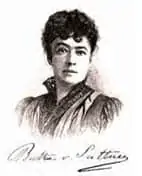Who was this woman and what made her so extraordinary? Where do we still find her portrait in everyday life today? What was her life like and when did she receive the Nobel Peace Prize? In Austria, they are known from the former thousand schilling bill. She can currently be seen on the €2 coins minted in Austria. Bertha Sophia Felicitas Baroness von Suttner was born in Prague on June 9, 1843 . She came from a Bohemian noble family and was a born Countess Kinsky. She achieved world fame as a writer, the first female Nobel Peace Prize winner (1905) and pacifist . But this was not something she was born with. On the contrary, her life was marked by many ups and downs. The father married a commoner and died before the daughter was born. The mother gambled away the entire inheritance. The plan to marry the daughter rich did not work out. At thirty, Bertha was still unmarried and took a job as a governess with the Suttner family in Vienna. There she taught music and language to the four daughters and fell in love with the youngest son of the family, the um seven years younger, Arthur Gundaccar von Suttner. Thereupon she was dismissed. She went to Paris and took a job as private secretary to the wealthy industrialist Alfred Nobel (Swedish inventor, chemist and namesake of the Nobel Prize). But her great love for Arthur remained. The couple married secretly in Vienna, he was then disinherited and they went to Georgia together. There she began to write out of a need for money. After almost ten years, the two returned to Vienna; Bertha was by now a recognized writer. She remained in contact with Alfred Nobel throughout the years; he was her great patron. Her novel “Lay Down Your Arms“, which made her world famous, was published in 1889. She traveled the world as a peace ambassador for the next several decades. In 1905, she was the first woman to receive the Nobel Peace Prize for her tireless efforts against war and violence. On June 21, 1914, exactly one week before the shooting in Sarajevo, she succumbed to cancer. Fortunately, she did not live to see the outbreak of the First World War, which she had repeatedly warned about. Time Travel Tip: A memorial to Bertha von Suttner has been erected in the Bertha von Suttner-Hof in the 4th district . It is a pedestal with a group of figures by the sculptor Siegfried Charoux
Image source:
https://commons.wikimedia.org/wiki/File:Bertha_von_Suttner.png?uselang=de



